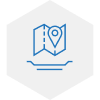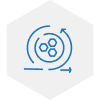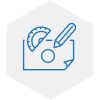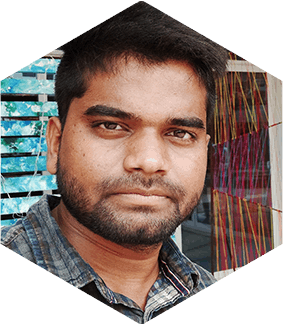Bachelor of Design (Product Design)
Product Design is a strategic problem-solving process that drives innovation, builds business success, and leads to a better quality of life through innovative products, systems, services, and experiences. The programme offered by Anant promotes impact through design. It educates designers to not only solve today’s problems but also propose new ways for the future.

For individuals...
who want to develop products, systems, services and experiences through a series of projects. It encourages students to charter their own personal learning path with support from the experienced faculty and design experts. The students will learn courses that are organized along three streams of interrelated activities

Looking for...
courses and activities that facilitate personal growth through learning about human-centred design, sustainable design goals, design of living cultures, indigenous art, culture and society, and design for social impact. Experience hands-on exploration derived from the learning-by-doing modules and develop concepts from theory-based courses.

To become...
- Product Designer
- New Product Development
- Entrepreneurship
- Service Design
- Systems Design
- Design Consultant
- Human-Centred Designer
Programme Highlights

FORM
DEVELOPMENT

SIMPLE
PRODUCT DESIGN

FUNCTIONAL
PRODUCT DESIGN

COLLABORATIVE
PRODUCT DESIGN

Human
CENTRED DESIGN
About the Programmes
- Semester 3
- Semester 4
- Semester 5
- Semester 6
- Semester 7
- Semester 8
Semester 3
After undergoing a common foundation programme, this semester introduces students to the concepts of human-centred design and its process. They learn to create innovative, effective, and sustainable solutions for social change. Students study 3-D forms, learn tools and techniques for product conceptualisation and communication materials and explore tools of visualisation along with model making skills. Students develop knowledge about materials, corresponding manufacturing skills and industrial design.
- Human – Centred Design
- Form Development
- Prototyping
- Product design Sketching & Rendering
- Materials & Processes for Product Designers
- History of Industrial Design
Semester 4 – Simple Product Design
Students explore tools and methods for creating new products while learning about product methodology, customer needs, product concepts, prototyping and design-for-manufacturing. Students discover visualisation tools, analytical tools for product development, manufacturing systems aspects and more. Students also learn about product ergonomics and concepts, practices and issues in contemporary design.
- Design of Living Cultures
- Simple Product Design
- Design for manufacturing
- Product design Sketching & Rendering
- Product Ergonomics
- Design in Context
Semester 5
The semester introduces students to the United Nations Sustainable Design Goals, the World Design Organisation’s Agenda and the importance of sustainable development. Students develop skills for research, problem identification, ideation, product design, material analysis and prototyping and implement them. They learn to create communication artefacts using traditional/digital tools and processes, 3D Computer-Aided Design (CAD) software to design and develop models and gain deeper insights into design user experiences. The semester also introduces them to design history and theory in connection with contemporary issues.
- Sustainable Design Goals
- Functional Product Design
- Computer Aided Industrial Design
- Digital Illustration
- Designing User Experiences
- Art, Design & Culture
Semester 6
Students explore techniques of participatory design to engage citizens and stakeholders to find solutions to complex problems and influence policy decisions. They learn about fundamental concepts used within Human-Computer Interaction (HCI) and take a closer look at usability and interactive technologies. Students gain a toolset to develop their approaches to conduct research for design and learn tactical skills to communicate their findings. The semester also introduces them to universal design thinking.
- Indigenous Art, Culture & Society
- Collaborative Design
- Design for Interaction
- Digital Rendering
- Need finding / Problem identification
- Universal Design
Semester 7
Students learn principles, tools, methods and approaches to design for social impact. They work on design projects based on real-world problems provided by our partners in the industry or the social sector. They learn to conduct in-depth research and write a research proposal as part of their project. They also learn how to map, design, assess, and test business models and delve deeper into issues in contemporary design practice at the intersection of digital technologies, ethics, and society.
- Design for Social Impact
- Academic / Industry Design Brief
- Research in Design
- Digital Rendering
- Business Model Generation
- Designing Futures
Semester 8
Students undertake projects and employ the academic and technical skills they have acquired during the entire duration of the course. They conduct in-depth research, reflect on concepts they have studied, interactions they engaged in with the faculty and the peers and decide on a topic or a problem they passionately associate with. They work on the project closely with the mentors and produce a substantial product that reflects a deep understanding of the topic.



